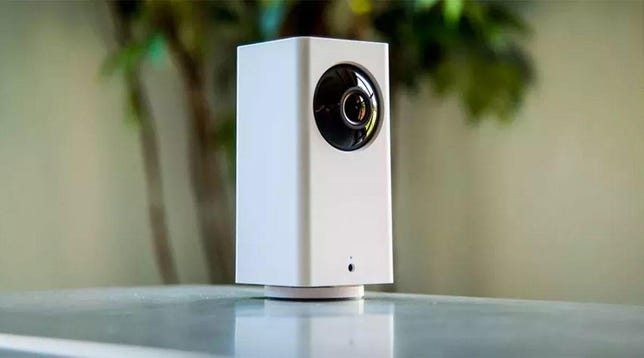
This story is part of Home Tips, CNET’s collection of practical advice for getting the most out of your home, inside and out.
You may have heard, or just always thought, that home security systems are expensive, they don’t work and are a hassle to deal with — a hassle that you’ll have to put up with for years because you’re locked into a contract. These lingering myths, among others, are largely no longer true, and shouldn’t prevent you from improving your home security setup.

Many home security system myths stem from the way professional services like ADT, Vivint and Xfinity work, but the inconveniences that once gave these services a bad rap are now largely obsolete. The arrival of DIY systems — Wi-Fi cameras, video doorbells, motion sensors and more — worked to further dispel many of the top misconceptions about home security.
Still, there may be the lingering, unfounded and outdated home security myth keeping you from committing to either a professionally installed or a DIY system. Here’s a look at seven common home security myths and what makes them just that: mythical. (For more home security tips, check out the three places you should never put a security camera, and how to use an old smartphone as a security camera.)
Myth: Home security systems are expensive
What’s the point of a home security system if the initial and ongoing costs outweigh the value of what was damaged or stolen? It’s a fair argument, but home security may be more affordable than you’d think, especially if you go the DIY route.
While it’s true that costs for a professional home security system can quickly add up, it’s not uncommon for home security companies to run special offers that could save you hundreds on equipment and installation. Depending on the provider and available promotions, it’s totally possible to get a basic system for free with installation included (yes, you’ll have to sign a contract, but more on that in the next section).
On the other hand, you’ll have to purchase all your own equipment for a DIY home security setup. Still, you can get everything you need to watch your home inside and out, complete with cameras and motion sensors, for a couple hundred bucks or less.
Professional monitoring isn’t available with all DIY devices, but if it is an option with your camera or security system, expect an added monthly fee of $10 to $25 for a typically unlimited number of devices. Fees are often lower if you pay annually instead of monthly.
Myth: You have to sign a contract, or at least have a subscription
Again, this one originated from professional home security service providers, and it’s admittedly still true in some cases. Most home security companies require a one- or two-year contract, particularly if you opt for any promotional offers like free equipment or installation. A contract is not always required, however: Some providers like SimpliSafe and Xfinity do not make you sign one.
And you won’t have to worry about a contract at all with DIY setups, as systems from Arlo, Ring, Wyze and others are always contract-free. Likewise, monthly subscriptions are not required, though you may want to add one for professional monitoring or more storage options. Subscriptions can cost as little as $10 per month (or even free, as is the case with Wyze and its “name your price” option with a Cam Plus Lite subscription) and cover an unlimited number of devices.
If you don’t want to pay for a subscription, no problem. Cameras, motion detectors and other DIY home security devices come with an app that lets you do your own monitoring. It can even assist you in your home security efforts by sending push notifications when a motion or sound event is detected.
Bottom line: Home security does not automatically come with a contract, subscription or anything else that requires an ongoing fee.
Myth: Home security systems are complicated

Whether professionally installed or DIY, home security systems are easier than ever to install and use.
Ring
I completely understand this potential hesitation. Whenever a home project involves wiring, I immediately file it under the “get someone else to do it” category.
Fortunately, when you go with a professionally installed home security system, someone else (a professional installer) will do the hard work for you. They’ll also walk you through how to use the system at the time of setup, and technical support along with online resources are available 24/7 for any problems you may have down the road.
As for DIY security devices, there shouldn’t be any wiring involved outside of simply plugging it in and connecting it to your Wi-Fi. Hardwired video doorbells are an exception, but I can say first-hand that installation is still fairly quick and straightforward. Either way, an app will guide you through all phases of installation, setup and use.
Myth: I need a landline for a home security system
Go ahead and follow that myth with “and burglars can cut it to disable my system.” A landline is no longer a requirement for home security systems, even professionally installed and monitored ones.
ADT, SimpliSafe, Vivant and Xfinity, among other professional systems, do not require a landline, which means no added cost for a phone service you wouldn’t otherwise use, and no risk of an intruder cutting the line.
You won’t need a landline for DIY devices, either, but you will need to connect them to your Wi-Fi. It’s unlikely an intruder is going to cut your internet cable and disable your system, but Wi-Fi networks and connected devices are indeed vulnerable to hacking. Be sure to take the proper precautions to keep your Wi-Fi connection secure.
Myth: I rent, so I can’t get a home security system

Indoor security cameras, motion sensors and even video doorbells are available for renters to boost their home security.
CNET
Your property and safety is important, regardless of whether you own or rent, and there are lots of home security solutions for renters. Such devices are often noninvasive (no holes in the wall, permanent wiring or mounts) and can come with all the home security features you’d need, including access to live camera feeds and recordings, push notifications, professional monitoring options and emergency response assistance.
Check with your leasing office or property owner before installing a system, and be sure to avoid any devices that may infringe on your neighbor’s privacy.
Myth: Home security systems aren’t effective
That depends on what you mean by “effective.” If someone is set on getting into your home, even the best security system will not stop them. That said, if someone is considering breaking into your home or swiping a package off your porch, the presence of a security system or surveillance camera is a good deterrent.
A study from the University of North Carolina found that about 83% of professional criminals interviewed stated they would try to find out if a home or business had a security alarm before attempting a burglary. Roughly 60% claimed they would seek out an alternative target if an alarm were detected.
Break-ins and thefts will still happen, unfortunately, but a home security system can make intruders feel less comfortable in your home. Activating alarms or spotlights and using two-way audio to tell an intruder that authorities are on the way can be enough to thwart any further criminal activity.
Even if the burglar is successful, your security devices may capture images, video or sounds leading to their identification and arrest. At the very least, you can use the information to alert your neighbors and help prevent future occurrences.
Myth: My insurance will cover a burglary
Most home and renter’s insurance plans will cover all or some of the costs to replace stolen goods or cover damages to your home, such as a broken window or busted door. However, many insurance providers put caps, or sublimits, on how much they’ll pay, so your total loss may not be fully covered by your insurance.
Also, keep in mind that insurance companies will reimburse you for the monetary value of replacing the physical item, but not the intangible or sentimental value that may come with it. Family pictures on your laptop, the personal attachment to a piece of jewelry, even all those hours you put into a saved video game file, can’t be replaced by the insurance company.
The bottom line on common home security myths
If you’re considering improving your home security setup or starting from scratch, don’t let that little voice in the back of your head saying “it’ll cost too much, you’ll need a landline phone” stop you.
While there is some merit to the negative perceptions of home security services and devices, many are either outdated or simply untrue. As with any home addition or service, do your research to find the best solution for your needs. You’ll likely find that there’s a device and accompanying app or service to debunk all the drawbacks you’ve heard or thought about home security.
For more, read up on the top home security mistakes you can make. Learn how to stop porch pirates, reduce the risk of car break ins and what you should keep in a safe.
